Tokiwa Mango Farm is located on Ishigaki Island, 410 km southwest of the main Okinawa island, and is run by owner Shun Yoshihama and his wife. Mr. Yoshihama, originally a plant lover, Mr. Yoshihama grew mangoes as a hobby for 10 years before deciding to become an official mango farmer after retirement. From there, he has been working a mango grower for more than 10 years, with the goal of growing the best mangoes in Japan.
Ishigaki Island is 2~3 degrees warmer than the main island of Okinawa, with an average annual temperature of 23° C, and is warm even in the middle of winter at about 18° C. Surrounded by the sea, it is a small island with a year round breeze filled with minerals, creating a favorable environment to grow delicious mangoes.
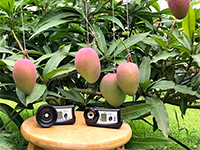

Tokiwa Mango Farm is quite particular about mango ripeness.
Mangoes fall naturally from the tree when they are ripe. The sweetness and richness come out by letting it ripen on the tree until the very last moment. Considering the shelf life, it is better to harvest the mangoes before they fall from the tree, but the taste will be lower than if it were to stay ripening on the tree. At Tokiwa Mango Farm, we are particular about not harvesting until right before it`s about to naturally.
Tokiwa Mango Farm sells only be the internet, so fruits are we sorted, boxed, and shipped from the farm.
So far, I`ve eaten tremendous amount of mangoes during harvest. If you look at a mango and think like "The coloring is a little different, let's taste it"… "The shape is a little different, let's taste it" … or even "The touch feels different, let's taste it." …then you become so full that there is no need for dinner! However, thanks to all of that, I can now understand the deliciousness of mango just by my eyes, nose and hands. Still, I think it is only to some extent.
If by using the PAL-HIKARI15 (mango) to measure objective numerical values, we will be able to deliver to our customers a mango with a firm and stable sweetness. I have high expectations for the PAL-HIKARI15 (mango). Also, I'm pretty sure there will be no more of me saying "I'm too full from mango ..."
■Click here for Tokiwamango Farm's online shop
Kita Tsukuba Agricultural Cooperative is using PAL-HIKARi 12 (Asian Pear).
Shinshu Suzaka Ota Farm Co., Ltd. uses our IR Brix and Brix/Acid Meter set for grapes.
Mr. Kenji Shinagawa of Natural Farm en is using our IR Brix and Brix/Acid Meter set for grapes.
Tekawa Farm grows peaches and plums in Fuefuki City, Yamanashi Prefecture, which is rich in nature and has clean water and air. The main varieties are "Kawanakajima Hakuto" and "Sakura" for peaches, and "Ripe Sun" for plums. With an emphasis on quality control, such as the acquisition of the agricultural production process management "Yamanashi GAP", we are working hard every day to sell safe, secure and delicious peaches and plums.
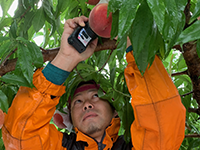
Whoelhearted Nurturing

For checking before shipping
I've always wanted a non-destructive Brix meter, but I gave up because it's expensive. I learned about Atago's IR Brix Meteer for peaches (PAL-HIKARi10), and the price was within an affordable range, so I decided to buy it. Unlike others, it is a small size and can measure peaches while they are still on the tree, which is very convineient. I'm glad I bought it.
We measure the sugar content of peaches before harvesting in the field and use it as an important guideline for the harvest time. We also measure for confirmation before shipping to the customer. These are peaches that a raised with all our heart and we want all our customers to be happy. In addition to sincerity, we ship with confidence because we measure the Brix, an objective indicator.
Naoi Pear Garden in Tochigi Prefecture is a very traditional pear garden that has been around for over 100 years for three generations. Naoi Pear Garden participates in the Utsunomiya Pear Agricultural Cooperative and is also making an effort to manage the cooperative. The union has a particularly high awareness of quality control and is actively incorporating new technologies.
For over 40 years, they have used ATAGO products starting from the analog handhelds up to the PAL series. They became interested in the PAL-HIKARi12 for pears after receiving a direct message from ATAGO.
Not having to bring fruit to the sorting plant, no squeezing or cutting, and being able to get the Brix% on the spot just by touching the sensor to the pear was fascinating enough for us to introduce it to our process.
Since the PAL-HIKARi12 can measure just by touching the surface, the measured pear can be shipped as it is. We can guarantee the quality to our customers with confidence, and there is a sense of security that we can finally confirm the pears that we have grown.
Ms Sonoe Mori is a strawberry farmer who grows strawberries in Date City, Hokkaido.
She moved to date city for her husband's transfer. She was interested in agriculture so joined the city farming support system to learn the technique of growing strawberries.
After the training, she became independentin 2018.

She knew ATAGO Brix meter during the training for new farmers in Date City. This time, she saw the advertisement of PAL-HIKARi 4 and bought it immediately.
She was suffering from poor coloring of her strawberry this year(2020), So she was observing her strawberry to see if they are growing healthly.
She is evaluatng ATAGO PAL-HIKARi4 as very useful device during branding her "salad strawberries" .because it enables to check the sweetness without damaging strawberry.She is also complimenting another device, PAL-BX/ACID 4 for checking balance of sweetness and acidity.
■Green Thumb Greenhouse Instagram
ATAGO always supports her strawberries that are beautiful, sweet and make people smile.
Inagaki Farm is an orchard located in the northern part of Wakayama prefecture along the Kinokawa river; favored with good weather and soil that is well-suited for growing peaches. They have been in business since the 1970’s, specializing in growing only peaches, selling and shipping directly to customers. Their peaches are known as safe, trusted, and sincere, Arakawa no Momo® (Arakawa’s peaches). These delicious peaches are picked in the morning and shipped the same day. PAL-HIKARi10 (Peach) is used to check the Brix (sweetness) of their peaches.

Grown and handled
with the utmost care.
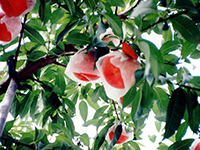
Peach trees laden with fruits
Before switching to PAL-HIKARi10 (Peach), peaches were measured using a Brix meter that required cutting and juicing extracts. The determining factor in choosing the PAL-HIKARi10 (Peach) was the fact that it can measure peaches in the orchard while they were still growing on trees.
The PAL-HIKARi10 (Peach) made it possible to check ripeness in the orchard field prior to harvest. A Brix (sweetness) measurement is digitally displayed simply by placing a sensor against the peach surface and pressing a start button. This makes it convenient that even seasonal workers can determine harvest time without any limitations to who’s measuring it.
Hakusuien is an orchard in the Oada Highlands, the gateway of Yoshino in Nara prefecture. They have been offering pears since 1894 and their Kachidoki pear was offered as a victory memorial for the emperor during the Russo-Japanese War. To measure Brix (sweetness) of their pears, they have been using a Brix meter, but since PAL-HIKARi12 (Asian Pear) was released, they now use the non-destructive Brix meter.

The Popular Housui Pear
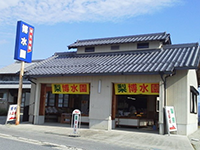
Delicious Pears for their Customers
They decided to purchase PAL-HIAKRi12 (Asian Pear) because it was portable and allowed them to determine harvest by taking measurements while pears were still growing on the trees. Its low price was also a determining factor.
Prior to purchasing the PAL-HIKARi12 (Asian Pear), they were using a Brix meter that required juicing the extracts. When juicing was required, it was almost impossible to measure all of the pears. Consequently, the harvest time was determined by looking at the size, color, aroma and the condition of the skin. With PAL-HIKARi12 (Asian Pear), the harvest time is determined by the Brix and it made farm operations smoother.
The Iwashita Farm is a fruit farm located in Asakura city, Fukuoka prefecture that produces and sells grapes and persimmons. They have Pione, Shine Muscat, and Queen Nina grapes. The PAL-HIKARi2 is used in their farm to measure the Brix before harvesting.
◆Watch here how they measure Brix using the PAL-HIKARi2

No More Grape Crushing
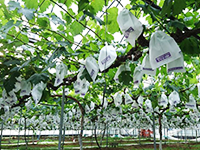
For the Best Quality
Before they purchased the PAL-HIKARi2 (Grape), they were measuring Brix (sweetness) by crushing and juicing the grape berries. They purchased the PAL-HIKARi2 (Grape) because they felt the price was justified for an instrument that can measure fruit non-destructively.
Amongst different types of grapes, the maturity of Shine Muscat is typically hard to determine by looking at its color. For this reason, measuring Brix had always been an integral aspect in determining the harvest time. However, the use of a refractometer that required destroying fruit only allowed them to test samples randomly. By using the PAL-HIKARi2 (Grape), they are now able to guarantee the quality of their grapes by measuring the Brix (sweetness) on all of them.

Yamaguchi Farm is a farm in Hasuda city, Saitama prefecture that has been growing Asian pears and persimmons for three generations. The scenery of their pre-harvest Asian pear orchard is posted on their website and each post conveys their dedication and passion for making delicious pears. Above all, their commitment in delivering safe and delicious pears to their customers is indisputable.
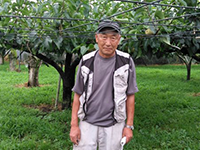
To Deliver Quality and Reliability
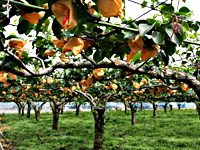
Waiting for the Harvest
Until now, they measured Brix by using the Pocket Refractometer from the PAL series. Now, they switched over to the PAL-HIKARi, a non-destructive Brix meter. This allowed them to sample all the fruit, eliminating time consuming juicing processes.
Last year, lack of sun caused Brix (sweetness) of their pears to remain fairly low. When they were using a Brix meter that required juicing, only random pears were sampled. Under this circumstance, the PAL-HIKARi12 (Asian Pear) was significantly useful allowing them to check all of their pears.This ensured superb quality to their customers.
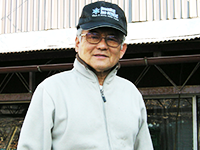
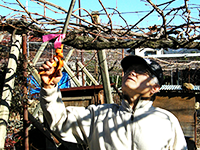
The grape berry can be classified by skin color, and loosely categorized as red, black and blue (yellow green). Due to its pigmentation, blue (yellow green) colored berries have always been difficult to measure. Sawada Farm valuing aesthetics have never been fond of plucking berries from a perfectly grown cluster. Plucking individual berries from a perfectly balanced cluster lessens the aesthetics of the whole. The commodity value is lost as well. The PAL-HIKARi2 (Grape) measuring Brix without destructing the individual grape is groundbreaking.
Thank you ATAGO!
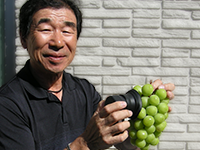
Determining by Brix is Very Important

Popular Shine Mascut
For more than 50 years, Amano Vineyard located in Kashiwara of Osaka has been dedicated to the growth of the most delicious grapes. Their Shine Muscat and Delaware grapes were awarded the Minister Award by Ministry of Agriculture Forestry and Fisheries. All grapes from Osaka are judged based on various categories including, Brix, berry size, balance, and color.
The Shine Muscat is known for its high price tag. The sweetness at the time of harvest is very important. With little to no change in color during the process maturation, it is one of the most difficult cultivars to determine the timing by its appearances. Amano Vineyard has always used a Brix meter for this reason, but it was time consuming and removing berries from a cluster diminished its aesthetics. They are extremely happy how easily they can estimate the harvest day with PAL-HIKARi2.
Chiba prefecture is one of Japan’s leading producers of nashi (Asian Pear). Iidaen is located in Kamagaya city, Chiba prefecture and produces Hosui, Akizuki, and Kaori pears.
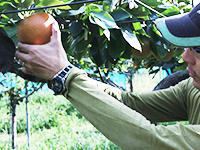
Without Cutting Pears
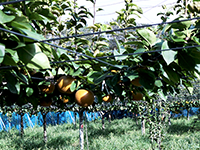
Produces Hosui, Akizuki,
and Kaori pears
They have been using ATAGO N-1E, a handheld refractometer to measure Brix (sweetness) of their pears. They have decided to purchase the PAL-HIKARi12 (Asian Pear) when this non-destructive Brix meter was as released.
Iidaen’s Hosui pears are only shipped when the Brix is 12% or more. With years of experience sweetness is somewhat predictable by looking at its color and shape. They are excited about the non-destructive Brix meter because it allows their employees to measure and know the Brix without cutting and destroying the pears.
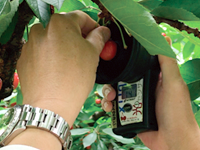
Measuring Just by Touch
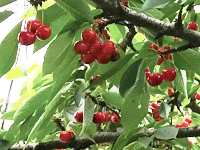
A Very Popular Tourist Farm
Harada Farm is a pick-your-own tourist farm where they offer Takasago, Seikounishiki, Satounishiki, Benishuuhou, and Napoleon cherries. They decided to let their customers use the PAL-HIKARI16 (Cherry) to measure Brix and compare with how it tastes. They liked how quickly Brix can be measured with the PAL-HIKARi16 (Cherry).
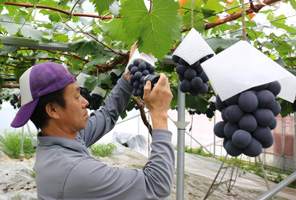
The PAL-HIKARi2 (Grape) was recommended by a friend to the Mochizuki farm. They used PAL-HIKAR2 (Grape) to check new cultivars and determine the harvest. They are fond of how small and lightweight the PAL-HIKARi2 (Grape) is and how easily grapes can be measured on the vines. They are happy that the price range is more affordable than other manufacturers’.
Established in 1930, Kudamono no Yamacho is a specialty fruit store that sells locally grown fruit from Kochi prefecture. They are using PAL-HIKARi12 (Asian Pear) to check Brix (sweetness) of their Asian pears.

To Measure Incoming Asian Pears
Using the PAL-HIKARi12 (Asian Pear)
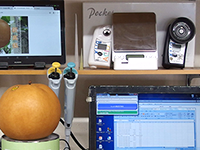
Using Near Field Communication
(NFC) to Transfer Data to a PC
Many customers buy fruit from Kudamono no Yaocho as a gift. They stock and sell fresh Asian pears and inspects all incoming fruit for consistent quality. To get the most accurate result, they measure multiple spots on a single pear and take the average.
Before they purchased the PAL-HIKARi12 (Asian Pear), they were using the PAL-BX/ACID12 (Asian Pear) and liked how it can measure both Brix and acidity with one instrument. For Brix though, they really like how easily all pears can be measured with PAL-HIKARi12 (Asian Pear).
The store manager, Mr. Yamamoto shared with us that they ask themselves, “Is what we consider ‘great tasting’ any different from what our customers consider ‘delicious’?
Is there anything that we can do now that we couldn’t do in the past?”
Their commitment to deliver the highest of quality to their customer is their strongest value. They value the quality they offer to their customers and those buying their fruit. Their professionalism and commitment are prominent in what they sell. What an honor that this kind of careful consideration goes into the fruit that are purchased as gifts for special occasions. Kudamono no Yamacho’s products are available online and also can be ordered over the phone.
How about a gift for someone special?
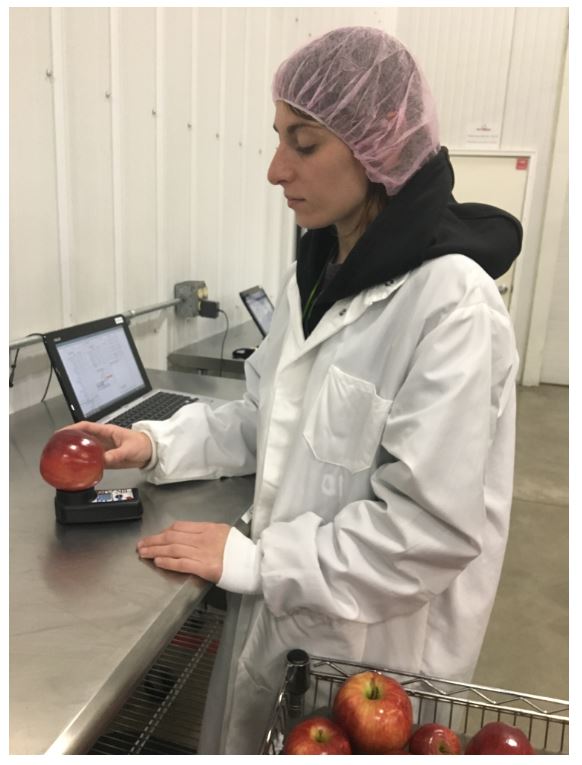
By using the PAL-HIKARi5 nondestructive brix tester for our apple sampling program we have decreased the time it takes for brix sampling by 75%.
The nondestructive tester helped with improving the efficiency of our sampling program. Now we can simply place the PAL-HIKARi5 on the uncut apple and in 5 seconds we have the brix for the apple. No more sticky, juicy messes and destroyed apples. By using this tester we have doubled the amount of apples we are testing while lowering the amount of time we spend on testing.